Good soil preparation has been found to have a significant impact on the uniformity of the product. Potato plants can grow more efficiently in loose and loamy soil. There are two ways to improve your soil condition. First, the soil varies in physical and chemical properties to the crop productivity. Let’s check out more information about the soil preparation for Potato plants.
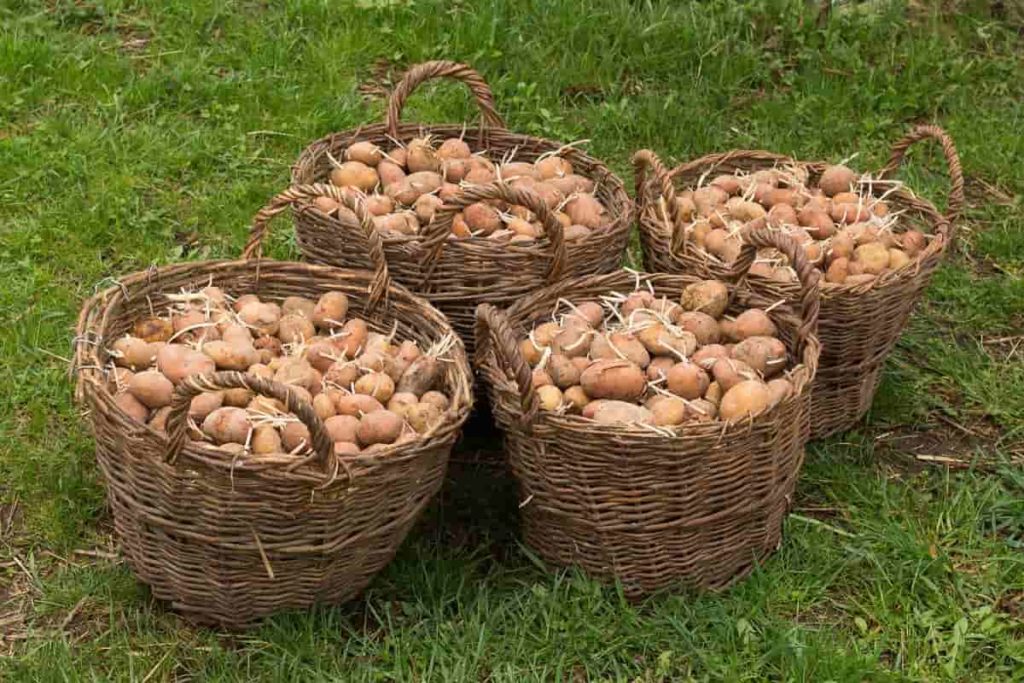
The chemical properties of soil can be handled relatively easily by including fertilizers and lime. However, changing the physical characteristics of the field can be more difficult, sometimes impossible. That is why field selection (combining the physical characteristics of the field with the requirements of the crop) is essential.
Potatoes will grow only in well-drained soil, but they dislike soggy soil. Since they do all their growing underground, they can spread more easily in heavy, compacted, looser than clay soil, in loamy soil that prevents plant roots from getting the air and water they need.
Soil preparation for Potato plants
Soil pH for Potatoes
Potatoes need a little special attention as they are heavy feeders. Potato growers, in general, ensure that there is plenty of fertilizer available during the growing season to ensure that their Potatoes contain enough nutrients. Although if you don’t have a suitable soil pH, all the fertilizers in the world don’t matter. Alkaline soil will prevent plants from absorbing nutrients, so it doesn’t matter how much fertilizer you give.
In case you missed it: Growing Potatoes In Balcony – A Beginners Guide
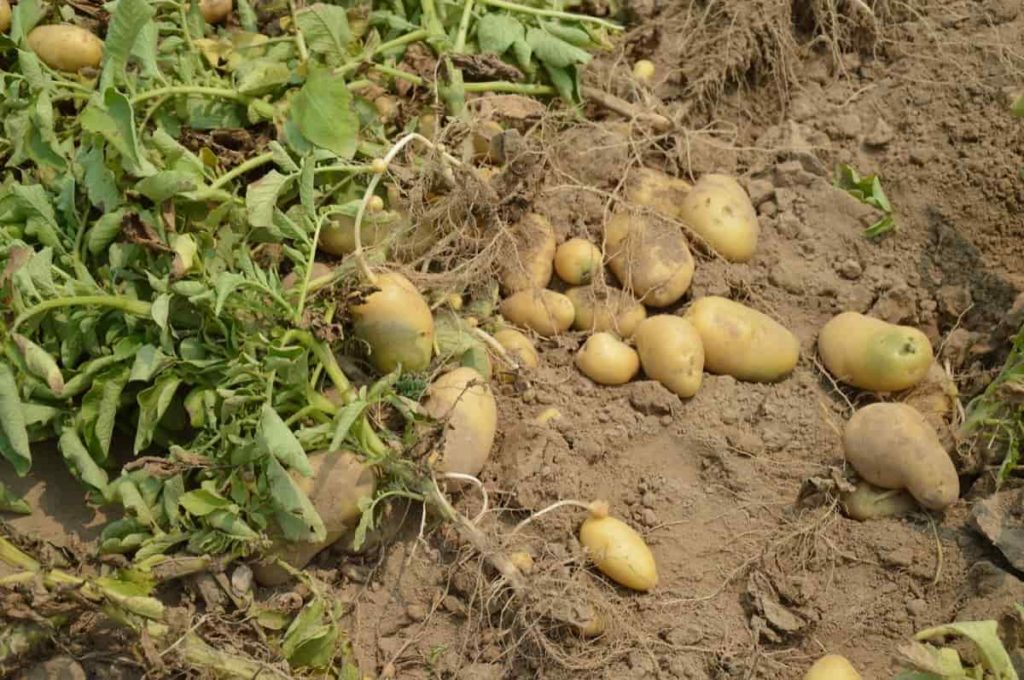
The maximum soil pH for growing Potatoes ranges from 5.0 to 6.0. Potatoes will tolerate overgrown up to 4.5 and 8.0 in high pH soil, but the crop will suffer. Potatoes grown in soil with 7.5 and higher pH will face phosphorus use and other micronutrient deficiencies, although they are present in the soil. Low pH acidic soil will also limit phosphorus use and molybdenum, resulting in young plants with yellow leaves.
If your soil is not at the proper pH, your Potatoes will not flourish. Soil pH is essential for Potatoes as it facilitates the use of nutrients and protects against some diseases. Growing Potatoes on neutral pH will still give you an average yield. You will only have problems if your soil is too alkaline or acidic. You will need to reduce your pH to make your soil more acidic. To do this, modify your soil with agricultural sulfur. You would like to use different amounts of sulfur depending on your soil type.
Remember to wait at least a month before planting to avoid burning your plants. If your plot is too acidic, add some wood ash or agricultural lime. If you are using lime, you need a complete soil test to know how much to add so that you don’t overdo it. Be careful when adding any amendments to your land. Start with small amounts of modification and recheck the pH before planting to ensure it is in the suitable range.
Preparation of soil for growing Potatoes in pots
Like the Potatoes are grown in the garden, Potatoes are grown in containers and need a rich, well-drained loamy soil. Potting with added sand, a mixture of soil and manure (about 20% of the total), serves Potatoes well. Add a handful of balanced organic fertilizer as you make a soil mixture. Use high-quality potting soil that is fast-draining, mainly if you use a plastic container. Organic soil is always a good choice too. Mix an organic, slow-release fertilizer in potting soil.
In addition to this upfront feeding, use a thin liquid fertilizer, such as fish emulation, every two weeks when your Potatoes grow. Potatoes grown in containers require plenty of water, which can extract nutrients from the soil. One of the advantages of using organic fertilizer is that it is much more forgiving if you accidentally put too much. But, again, the potting mix made especially for containers will work. If you are mixing yourself, a good mix is 1/3 good quality ready-made manure, 1/3 vermiculite or perlite, and 1/3 coconut coir or peat moss.
In case you missed it: Guide to Growing Potatoes in Texas: At Home, In Backyard, Containers, In Winter and Summer

Preparation of soil for growing Potatoes on grounds
Proper bed preparation for Potatoes is of primary importance. Ignoring the preparation of Potato beds can result in lower crops. The first rule of preparing a Potato bed is to never plant Potatoes in the area where another plant of the Solanaceae family has been planted earlier. It can increase the infection of pathogens. The best area for planting Potatoes is where legume plants have been planted first.
Potatoes need well-drained soil. If your soil is poor drainage or is heavy soil, consider using raised beds. Adding organic matter (manure, covering crops, well-rotten manure or leaves) before growing Potatoes is an excellent way to improve the soil. Go quickly to sources of high organic matter in nitrogen and nitrogen fertilizer as too much nitrogen can encourage lush leaves at the cost of producing tuber.
How to Grow Potatoes in clay soil
Potatoes grow best in well-drained, loose, and high organic matter soil. Soil that is very sandy, rocky, or clay does not work well for Potatoes. If you have clay soil, the soil should be double shoveled and raked or at least 10 inches deep. The pH for growing Potatoes is 5.5 to 6.0, which is less than most vegetables as Potatoes favor more acidic soil. Potatoes need 1.5 inches of water every week, more during dry spells. Do not water from the top, but water with drip irrigation or a soaker hose.
Weeding Potatoes are essential for disease and pest control; however, you can grow Potatoes using plastic mulch. Potatoes may get early membranes, small round brown spots with a target-like spot in the middle. It will kill plants and is caused by plant debris in the bed you plant them during winter. Plant rotation with Potatoes is essential. Do not grow Potatoes in the same bed for four years. Clean the garden in the fall.
Soil composting for Potatoes
Compost will help improve most soil types, not just clay soil. This is because compost contains organic materials and nutrients. Compost helps in making soil structure while also feeding plants. The higher the organic matter material in general, the better the soil productivity. Therefore, efforts should be made to maintain organic matter content above three percent.
The presence of organic matter enhances the soil structure; improves its moisture, air, heating, and nutritional system; and reduces the chances of soil erosion. The best part is making compost from the yard and kitchen scraps that you may already have. Compost and covered crops can help replace some nutrients in the soil, but sometimes fertilizer is essential. It is especially true if you are growing heavy feeder crops that use a lot of nutrients in the soil.
In case you missed it: How to Grow Potatoes in 20 Steps: Secrets, Tips, and Ideas
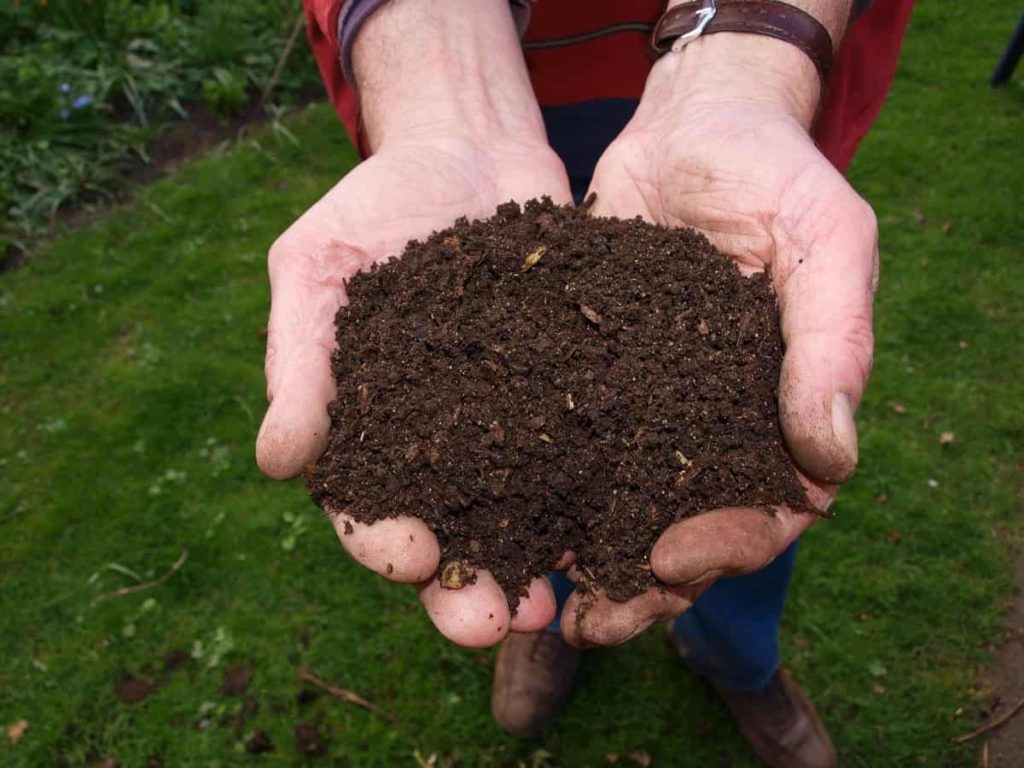
Chicken manure is suitable for growing Potatoes as it contains a lot of nitrogen, which helps grow Potatoes. However, you make sure that the manure is old and allowed to decompose. It would be best if you never used fresh manure to grow plants. Fresh chicken manure has a lot of nitrogen and also contains some salts. When using chicken manure (or any other fertilizer) in your garden, there are some guidelines to keep in mind:
- Allow manure to break entirely for 3 to 12 months. Then, to decompose it quickly, turn it with a pitchfork or shovel each time, and add water if it dries.
- Properly aged manure should look like soil. You should not see any saws, wooden shavings, straw, or animal beds in proper age manure.
- Mix the manure with compost and soil before putting it in the garden. It will reduce the concentration of nitrogen and salt in compost.
Land preparation for Potatoes
A well-leveled field with a good grade is essential for Potatoes. It is better to rotate Potato production in different fields so that Potatoes are not grown in the same field for consecutive years. Potatoes produced continuously in the same field can cause disease organisms, soil worms, and weed problems, increasing production costs and reducing production. You should open up the field with deep tillage to allow drainage and accumulated salts to be removed from the root area.
The plows do not open the soil so deep that drainage is needed. Instead, use a chisel or a ripper for deep farming. The chisel and the ripper break the soil from a depth of 60 to 70 centimeters without turning the soil over. You can use a large ripper to open the soil to a depth of about one meter in case of severe computation or purity. It is better to plant Potatoes in enough moisture soil to start the crop. Irrigating newly planted Potatoes will cool the soil, lock the soil in the air and start weeds.
Unless there is enough rain to wet the soil to a depth of 30 centimeters, it is already helpful for irrigation. Having enough moisture will also simplify soil and help control weeds in the early season. Soil moisture of 70% to 80% field capacity is ideal for most soils. You can build temporary borders, and the field may be flooded. Since the water requirements vary from crop size and growth phase and the length of their maturity and maximum growth year time, irrigation scheduling aims to plant adequate quantities of water in due course.
In case you missed it: Growing Baby Potatoes In Pots – Indoors At Home
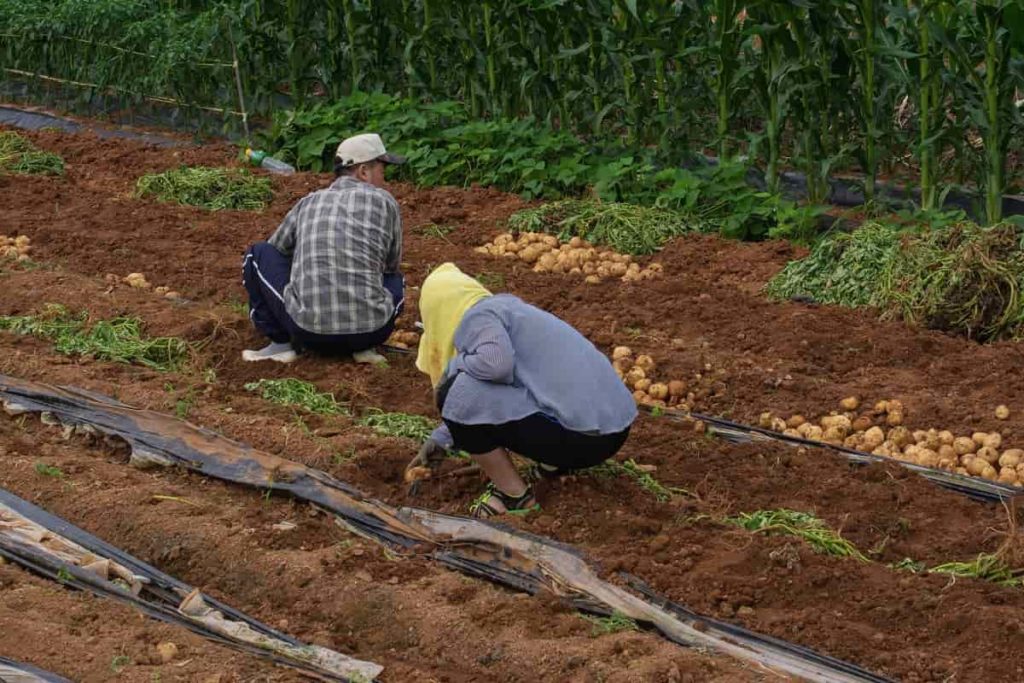
Best soil mix for Potatoes
Potatoes need deep, loose, free-draining soils that are slightly acidic with much organic matter. They grow best in the soil mix containing compost, well rotten manure, and straw. Add mature compost and straw mulch are the best options if you can’t make manure at home. The use of fresh potting soil reduces the risk of damage from soil-generated diseases and harmful pest larvae.
The containers themselves protect the tubers from hungry rats and other insects. And when it’s time to harvest, you have to throw out the container material: no digging is necessary, so there’s no worry about accidentally stabbing Potatoes with a digging fork.
Soil recipe for Potatoes
To encourage healthy growth and prevent decay, use a standard, light potting mix that maintains moisture yet drains excess water. The quick way to do this is to combine a part of the soilless potting mix with a portion of the compost. Alternatively, mix equal parts, coconut coir, perlite, vermiculite, and compost. Coconut coir will help in moisture retention and proper drainage and provide an ideal pH level of 5.2 to 6.3.
It is essential not to use plain garden soil in a Potato container garden, as it will be easily compacted and thus drained badly, yet it will dry quickly. In addition, the garden soil may contain weed seeds and diseases that otherwise will not be present in the container garden.
Natural soil amendments for Potatoes
Adding organic matter (compost, covering crops, well-rotten manure or leaves) before growing Potatoes is an excellent way to improve the soil. You can also modify soil with 3 to 4 inches of composted steer manure or an inch of composted chicken manure, 2 to 3 kg bone meals per 100 square feet, and kelp or seaweed meal.
When preparing a bed for Potatoes, remember that they are heavy feeders, so proper nutrition is essential at the beginning. You can use coffee grounds; take care not to use too much coffee grounds that contain a lot of nitrogen when planting Potatoes as the grounds, which is unnecessary for good Potato production.
What to plant after Potato harvesting?
Crop rotation keeps your soil healthy by managing disease, insects, and weeds in vegetable gardens. When used to maintain your soil health, rotating crops can also include nutritional benefits. For example, some plants you can grow with Potatoes will add nutrients to the soil to help them grow when your Potatoes are growing. These include Maize, Chives, Cilantro, Marigold, Flax, and Nasturtiums.
In case you missed it: Potato Growing Tips, Ideas, Secrets, and Techniques
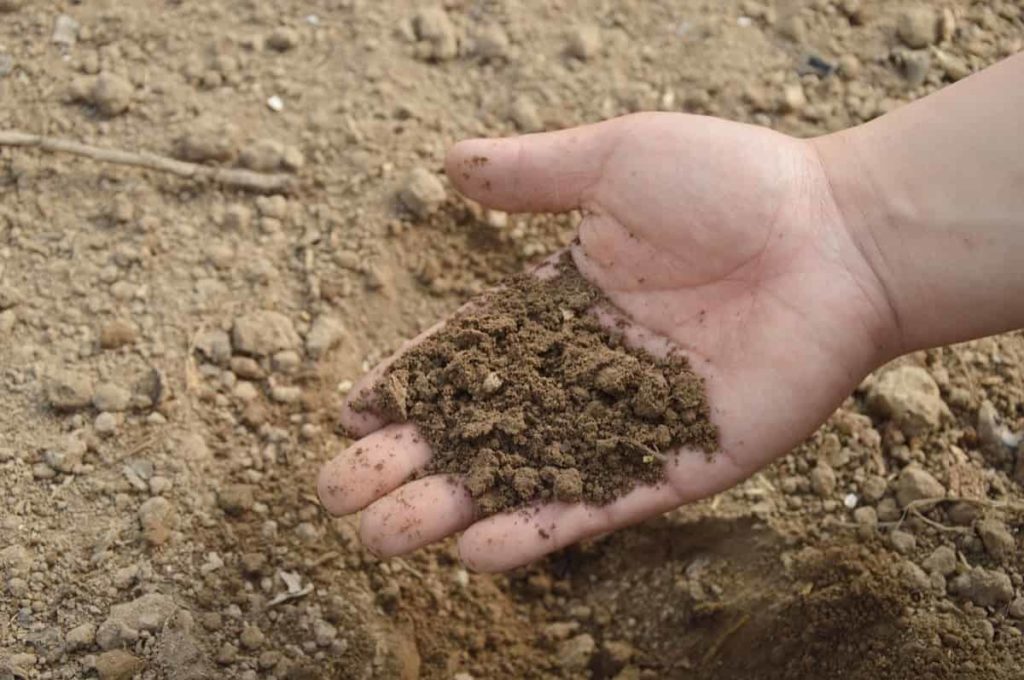
Sugar snap peas, green beans, and other beans add nitrogen to the soil with your Potatoes or when applied as a different crop for the season. Plants like marigold and nasturtiums work as pest prevention when planted with your Potatoes. Flax and Cilantro grown with Potatoes attract beneficial insects and prevent destructive pests. All these plants help the soil during and after the growth of your Potatoes.
Well-drained, fertile soil sown slightly acidic and well-drained like Potatoes, but does not need the suitable needs of what to plant after Potatoes. Instead, what you plant needs to meet your Potato needs. If you dig diseased Potatoes, you need to plant their next crop elsewhere for about three years. It is because of how long it will take you to get rid of the soil of this disease. If you can identify the disease, you can grow a crop after Potatoes that are not affected by the same pathogen.
Before considering when to plant after Potatoes, make sure you have time and fertile soil free from pests and diseases. While you can grow other root crops after Potatoes, it is discouraged. Beetroot, Parsnips, and other root crops are susceptible to the same insects that enjoy Potatoes. Instead, you will be better planted using space to grow a crop that will add beneficial nutrients to the soil for the Potato crop next year.
- Broccoli Seed Germination and Selection
- Asparagus Seed Germination and Variety Selection
- Seasonal Flower Gardening: Best Practices for Spring, Summer, Fall, and Winter
- How to Grow Hibiscus from Flower
- Plantation Ideas for Home Decoration: A Beginners Guide
- Flower Garden Designs and Layouts for Beginners
- Planting and Spacing Techniques in Papaya: A Beginner’s Guide
- Growing Gold: Essential Techniques for Planting Pineapples
- How to Make Kalanchoe Plant Bushy: Home Remedies and Solutions
- 11 Reasons Why Your Gardenia is Not Blooming: Home Remedies and Solutions
- Eco Elegance: The Guide to Designing a Drought-Tolerant Landscape
- Gardening on a Slope: Strategies for Hillside Landscaping
- Nourish and Flourish: Top Organic Mulches for Thriving House Plants
- Everything You Want to Know about Indian Mogra Flower: Discover Uses and Growing
- Green Thumb Success: Expert Tips for Cultivating Greenhouse Pumpkins All Year Round
- Maximize Growth & Flavor: The Ultimate Guide to Companion Planting in Herb Gardens
- How to Control Rhododendron Problems Naturally: Home Remedies and Organic Ways to Fix Them
- Natural Magic: The Remarkable Benefits of Cinnamon for Plants
- Best Steps to Revive Dying Tulip with Natural and Organic Treatment
- 10 Reasons Why Your Angel Trumpet is Not Blooming: Remedies and Treatment
- How to Fix Periwinkle Leaf and Flower-Related Problems: Natural Remedies and Solutions
- How to Fix Zinnias Leaf and Flower Problems: Discover Natural and Home Remedies
- Organic Steps to Induce Lemon Tree Flowers: A Comprehensive Guide
- Bloom Booster: Crafting the Perfect Homemade Bougainvillea Fertilizer
- Optimizing Growth: A Guide to Applying NPK Fertilizer for Potted Plants
- 10 Best Homemade Fertilizers for Rubber Plant: DIY Recipes and Application Method
- How to Boost Female Pumpkin Flowers: Effective Steps for More Flowers and High Yields
- Transform Your Indoor Garden: Top Benefits of Pink Salt for Houseplants
- 10 Best Homemade Fertilizers for Peacock Plants (Calathea): Easy DIY Guide
- Unlock Blooms: 9 Reasons Why Your Potted Chrysanthemum is Not Blooming
- 8 Reasons Why Your Potted Hibiscus is Not Blooming: Fix it with Simple Solutions
- Unlock Blooms: 9 Key Reasons Your Potted Frangipani Won’t Flower
- 10 Reasons Why Is My Ice Plant Not Blooming: Remedies and Treatment
- 10 Reasons Why My Potted Hydrangea Not Blooming: Treatment and Remedies
- 10 Reasons Why is My Wisteria Not Blooming: Remedies and Treatment
- 10 Reasons Why is My Goldfish Plant Not Blooming: Remedies and Treatment